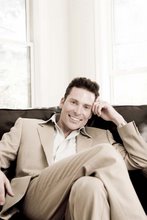 “Go confidently in the direction of your dreams. Live the life you have imagined.” -- Henry David Thoreau
“Go confidently in the direction of your dreams. Live the life you have imagined.” -- Henry David Thoreau
SPORT CAN BE a metaphor for life.
The thinking goes like this: By taking part in athletics, we learn to commit to a worthy endeavor, we come to understand that fear can be channeled into positive motion and we learn to push past what we thought was possible. That forces us to recalibrate our self-image which sends our confidence skyward and our lives on higher arcs.
If indeed this is true, then the sport of triathlon may be the ultimate metaphor for life.
On April 1st, my wife Alexandra and I completed the Lavaman Triathlon on the big
It was an extraordinary day for us both, mostly because we shared the experience. After finishing my event, I hopped on my bike and pedaled the last portion of the 25-mile ride with her, and then we ran every step of the 10k run together.
As is often the case with triathlon, many life lessons were revealed, and reconfirmed. Here are four that we experienced:
LESSON #1: Most things are not as difficult as they seem.
We tend to build up difficult tasks in our mind. At a point, the mental barriers can become more formidable than the physical ones. Once we finish the task, we often think to ourselves: “That wasn’t so tough! I made too big a deal of that!"
So went the thinking for Alexandra and her triathlon. I was her coach for the six weeks leading up to the event, and while she was well incredibly well prepared (I was her coach…come on!), her doubts grew as race day neared. Understandable. The triathlon can be a daunting challenge. But, the doubts started to erode her confidence forged from weeks of training, and she began to wonder if she should do the event at all. Fortunately, a glass of wine and some serious cajoling and wheedling on my part convinced her that she should.
And sure enough, with the aquamarine waters of
When we were kids, we thought anything was possible. We didn’t give much thought to our own limitations. We’d see a tree, we’d climb it -- and we’d get stuck in it! The world was our oyster. Yet as we age, we tend to approach new challenges with more trepidation than optimism. We unconsciously list the reasons why we shouldn’t pursue something, rather than why we should. We become caution experts. That can chip away at our spirit, our sense of adventure, and our ability to have fun and feel youthful.
Human beings have a phenomenal capacity for heroism. Ordinary people achieve extraordinary feats every day. We all have this power in us, but the mundane, rote nature of daily life can “tamp down” that heroic fire in each of us. Participating in athletics can fan the flames and draw out our inner heroes.
LESSON #3: We can do (almost) anything with the help of others.
You’ve likely heard this countless times: “Seize the day. Make the most of every moment.” Wonderful advice, but the fact is: it’s not always possible. In life, most moments cannot be “seized” or “made the most of.” When I’m sitting in traffic and I’m cranky and dehydrated and hypoglycemic, there’s no way I’m going to “seize the moment.”
If you’ve always wanted to climb a mountain with your kids, do it. If you want to run a marathon, do it. It you want to marry the woman or man you love, do it. If you want to lose 50 pounds, DO IT! Don’t want until the first of the month, or your birthday or the “perfect moment” or the summer solstice or harmonic convergence. Start planning it, and willing it, today.
Strive for your loftiest goals, because the fact is: most things are not as difficult as they seem, we are stronger than we know, we can do almost anything with the help of others and life is a series of notable moments. Make the most of each one -- and create as many as you can.






